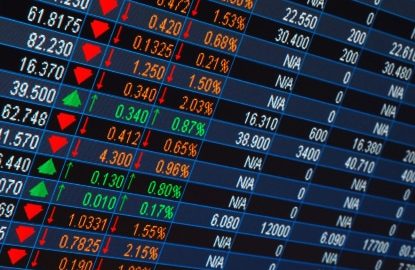Articles about “financial markets”
Bond investments – via yield and spread
How do I choose corporate bonds for my investment? In the current blog article, our expert Johann Griener gives an insight into the currently achievable yields of different credit rating segments. He also explains the spread that can be achieved with corporate bonds.
Investing in the bond market – the charm of short maturities
When should one invest one’s capital in the bond market and which maturity would currently be favourable? These questions are not so easy to answer and depend, among other things, on the preferences of the respective investor. In our recent blog, expert Johann Griener gives an insight into the current market environment and clarifies the most important questions about bonds and maturity.
5 tips for building capital with investment funds
For many investors, a fund savings plan is a useful way to build up capital over the long term. To make sure this works, our expert Johann Griener has 5 useful tips for getting over difficult market times.
How to invest in corporate bond funds
Yields on corporate bonds in both the investment grade and high-yield segments have risen significantly in recent months. This means that there are currently interesting entry levels again.
Our expert Johann Griener explains in his blogpost how to take advantage of this opportunity with a corporate bond fund.
How a bond fund “works”
Interest rates are back, which means that investing in bonds and bond funds again offers opportunities for attractive returns. Our expert Johann Griener explains how a bond fund works and what you should bear in mind when investing.

Interest rates are back
After many years of low interest rates, the tide has turned in recent months. This is also creating some opportunities on the bond market again, as our expert Johann Griener explains in his article.
Dividend strategy: falling prices may still come with opportunities
Corrections on the markets are often painful, as previous price gains are reduced or the investment even slips into the loss zone. However, price declines can also offer opportunities. Our expert Johann Griener presents a possible entry strategy for the dividend share segment.
The “Squirrel Principle” – get through winter on dividends
Dividend shares provide regular profit distributions even in difficult times on the stock market. This makes them particularly interesting in the current market environment.
Growth fears
Inflation has been the underlying factor in economy for some time. A recovery of GDP on a pre-pandemic level should be reached soon. The probability of a growth phase has increased. What further developments are expected?

Ethical, environmentally conducive, lucrative: what is sustainable investment?
I have my ethics and morals: more and more people want to invest their capital ecologically and ethically. What is sustainable investment and how does it work?
New year gains for stock markets as hopes for end of trade dispute increase
As hopes for an end to the trade war between the US and China increase, the stock markets reflected the sentiment with gains at the outset of the new year. Find out more in the new blog entry.
Stock markets in 2018 – market activity dominated by politics and volatility
2018 was a year of politics in the stock markets. Find out which three major topics dominated the international market activities in the current year.
Financial Markets Monitor September – conclusion: cautiously optimistic
As long as the underlying investor sentiment remains positive and investor confidence does not tilt, we are optimistic about the autumn on the capital markets. Find out more about the outlook for the global financial markets in our new blog.
Financial Markets Monitor August: We remain optimistic
The month since the previous meeting in July had been a positive one for investors willing to take risks. Thus, the optimistic risk stance of our team paid off. It is therefore not surprising that the team remains optimistic.

A brief history of time.. and markets
In the nineteen-sixties, mathematician Benoit Mandelbrot noticed something that experienced traders had known for long: that time at the stock exchange does not always run the same. Read about the relativity of time here.
Rising interest rates in the USA
The sentiment of the financial market participants has deteriorated in the past months, with the losses across numerous asset classes in the year to date seemingly the driving factor. Now we have to ask ourselves: are we at the outset of a new trend, or is this just a case of increased volatility? The general decline in prices has gone in conspicuous tandem with the increase in three important financial market ratios:
Financial Markets Monitor April: upside-down scenario
On 3 April, we held our monthly Investment Committee meeting. Only three weeks after the previous one – three weeks that were tightly packed with issues, as we can see in the performance data of the most important asset classes. Equities and high-yield bonds have lost value, whereas Eurozone government bonds and emerging markets bonds have recorded gains. An upside-down scenario, compared to previous months.
The global economy based on the Goldilocks principle
The global economy is growing moderately, inflation is low, and the monetary policy is loose. This environment supports many asset classes from bonds to equities. The political uncertainty has been absorbed rather well so far too. Will this situation last?
China – the biggest economy in the world
The new normal The importance of China for the global economic and financial system continues to grow at a rapid pace. Last year the country set a new milestone by becoming the world’s biggest economy. The total value of goods and services produced in a year exceeds that of the United States. Thus, at 30% […]
Boon and bane
The driving topics on the financial markets are the stabilisation of the oil price, mixed economic indicators globally vs. positive economic indicators for the Eurozone, the temporary decline in escalation risk, and the expansive central bank policies.
What has become of the “oil x 20” rule?
The oil and gas sector is the backbone of the Russian economy. It contributes roughly a quarter to the Russian GDP, and it accounts for almost two thirds of exports. Oil and gas companies represent almost 60% of the market capitalisation of the Moscow stock exchange. It therefore makes sense to analyse the performance of […]
The effects of the ECB policy
Since the cutting of key-lending rates to almost zero in the Eurozone did not suffice to keep the inflation expectations at their long-term target of slightly below 2%, the ECB Council decided in January to expand the central bank money supply until the accomplishment of the target was foreseeable. The possible effect on the financial […]
Light and shadow
The environment has become a bit brighter in the past weeks. In addition to the improvement of the economic environment in the Eurozone and Japan, more and more central banks loosened their monetary policies. For example, on 12 February the central bank of Sweden (Riksbank) surprisingly cut its key-lending rate to -0.1% and announced to […]



















